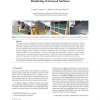Free Online Productivity Tools
i2Speak
i2Symbol
i2OCR
iTex2Img
iWeb2Print
iWeb2Shot
i2Type
iPdf2Split
iPdf2Merge
i2Bopomofo
i2Arabic
i2Style
i2Image
i2PDF
iLatex2Rtf
Sci2ools
CGF
2008
2008
A Resolution Independent Approach for the Accurate Rendering of Grooved Surfaces
This paper presents a method for the accurate rendering of path-based surface details such as grooves, scratches and similar features. The method is based on a continuous representation of the features in texture space, and the rendering is performed by means of two approaches: one for isolated or non-intersecting grooves and another for special situations like intersections or ends. The proposed solutions perform correct antialiasing and take into account visibility and inter-reflections with little computational effort and memory requirements. Compared to anisotropic BRDFs and scratch models, we have no limitations on the distribution of grooves over the surface or their geometry, thus allowing more general patterns. Compared to displacement mapping techniques, we can efficiently simulate features of all sizes without requiring additional geometry or multiple representations. Categories and Subject Descriptors (according to ACM CCS): I.3.3 [Computer Graphics]: Picture/Image Generati...
| Added | 09 Dec 2010 |
| Updated | 09 Dec 2010 |
| Type | Journal |
| Year | 2008 |
| Where | CGF |
| Authors | Carles Bosch, Xavier Pueyo, Stéphane Mérillou, Djamchid Ghazanfarpour |
Comments (0)

